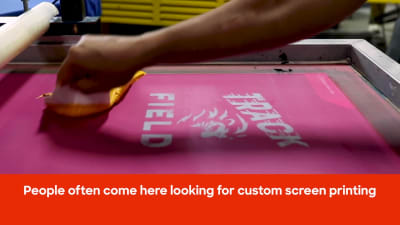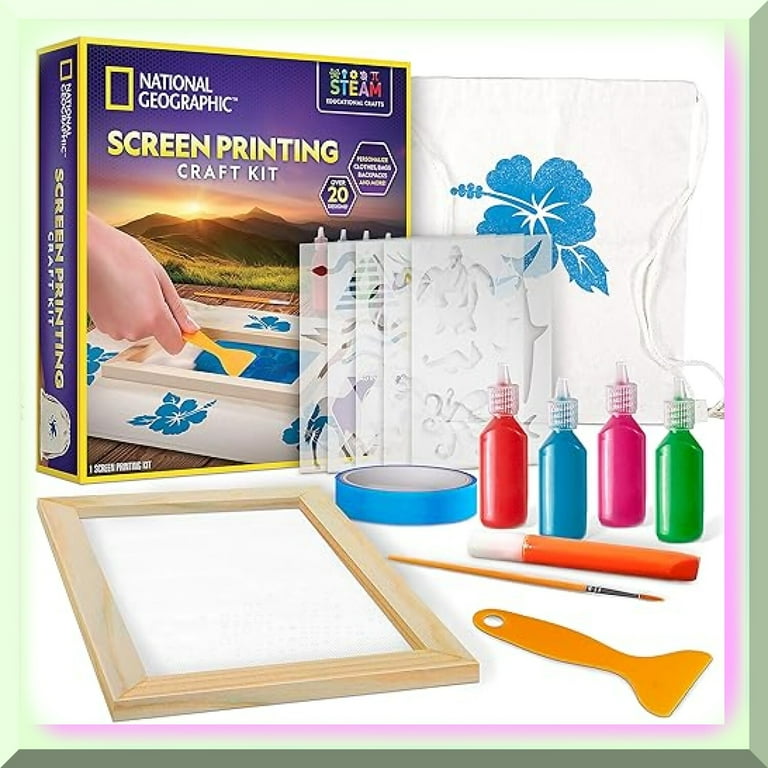Affordable Screen Printing Kit for Home Use
Affordable Screen Printing Kit for Home Use
Blog Article
Screen Printing Uncovered: Every Little Thing You Required to Find Out About Tee Shirt and Garment Printing Methods
If you have actually ever before asked yourself how those dynamic designs wind up on your preferred tee shirts, you're in the appropriate area. Display printing is a remarkable approach that combines art with method, offering limitless opportunities for creative thinking. Recognizing the principles, from tools to ink options, can substantially impact your outcomes. All set to discover the vital aspects that make display printing an art type? Allow's discover the details that can elevate your projects.
The Basics of Display Printing: Exactly How It Works
When you plunge into display printing, you'll find it's both a science and an art. At its core, screen printing entails creating a pattern, or screen, that allows ink to pass through just in particular locations.
Setting the screen over the fabric, after that utilize a squeegee to push ink with the display onto the garment. Each action is vital, and understanding them will certainly boost your display printing abilities, transforming basic garments into distinct, expressive pieces.
Types of Display Printing Strategies
As soon as you comprehend the fundamentals of display printing, it's time to check out the various techniques that can raise your designs. One preferred method is standard display printing, where ink is pressed via a stenciled screen. This technique is great for strong, dynamic shades. There's water-based ink printing, which provides a softer feel and is green, however it calls for a various strategy to healing.
An additional choice is plastisol printing, recognized for its toughness and brilliant shades, making it a preferred for lots of brands. Experiment with halftone printing to produce gradient effects and complex styles.
Important Devices for Screen Printing
To attain spectacular outcomes in screen printing, having the right devices is basic. You'll need a sturdy screen printing frame, which holds the mesh that moves your layout onto the garment. Next, spend in premium mops; these are essential for applying ink evenly throughout the display.
Selecting the Right Inks and Products
When picking inks and products for display printing, you require to take into consideration the sort of ink that works best for your project. Think of fabric compatibility to guarantee your designs look terrific and last lengthy. Check out environmentally friendly ink choices to make your printing procedure more sustainable.
Kinds Of Screen Inks
Selecting the appropriate screen ink is essential for accomplishing vivid, long lasting prints that satisfy your job's needs. There are a number of kinds of screen inks to analyze. Specialized inks, such as glow-in-the-dark or metal, can add one-of-a-kind results to your styles.

Material Compatibility Factors To Consider
Recognizing fabric compatibility is vital for accomplishing premium screen prints, particularly since different products react distinctly to numerous inks. Constantly test your inks on example textile to assure they adhere correctly and maintain shade stability. In addition, keep in mind that fabric weight and appearance can impact the last result, so selecting the appropriate ink and material combination is vital for your project's success.
Eco-Friendly Ink Options
Environmentally friendly inks are coming to be a prominent option for display printers who wish to lessen their ecological effect while maintaining top quality. When selecting inks, think about water-based inks, which are less dangerous and simpler to clean up compared to conventional solvents. These inks bond well with materials, delivering lively outcomes without hazardous chemicals. You could also discover eco-solvent inks that utilize fewer unpredictable organic compounds (VOCs), making them a safer option for both your health and the earth.
Furthermore, look for inks made from renewable energies, such as soy or vegetable-based choices. By picking the appropriate inks and products, you'll not just create stunning designs but also add to an extra sustainable printing procedure. Make the button, and your prints will reflect your dedication to the environment!
Preparing Your Layout for Screen Printing

File Style Demands
To assure your layout looks sharp and lively on click this site material, you'll need to pay attention to submit style needs for screen printing. Begin with vector documents like AI or EPS, as they can be scaled without losing top quality. If you make use of raster pictures, decide for high-resolution documents, such as TIFF or PNG, ideally at 300 DPI. Prevent making use of JPEGs, as they can shed clearness when resized. Additionally, make certain your design has a transparent history to prevent undesirable white edges on your prints. Finally, maintain shade modes in mind; CMYK is typical for display printing, so transform your RGB designs accordingly. By adhering to these standards, you'll establish your artwork up for an effective print.
Shade Splitting Up Techniques
Shade separation is an important step in preparing your style for screen printing, and grasping it can substantially boost your print high quality. You'll need to damage your layout into private colors, as each shade requires a different display during printing. This precision not only assures exact shade depiction yet likewise streamlines the printing procedure.
Resolution and Size
Achieving the very best lead to screen printing starts with ensuring your design has the ideal resolution and size. Ideally, your artwork ought to be at the very least 300 DPI (dots per inch) for sharp, clear prints. If you utilize reduced resolution, your end product may look pixelated and unprofessional.
When it involves dimension, consider the dimensions of your print area. Design your artwork to match the last print dimension, preferably developing it in the real dimensions you'll be printing. This way, you'll prevent any kind of unexpected scaling concerns.
Always check your layout in both vector and raster layouts. Vector graphics can be scaled without shedding top quality, making them optimal for display printing. Preparing properly will assure your layout looks incredible on every garment!
Step-by-Step Screen Printing Process
Display printing is a vibrant procedure that permits you to develop vibrant designs on different surface areas. To get begun, you'll require a screen, emulsion, and your selected ink.
Put ink onto the display and make use of a squeegee to press the ink with the stencil onto the material. Raise the display meticulously and let the print completely dry. You've effectively screen printed your design.
Tips for Effective Screen Printing Projects
While you're diving right into your display printing projects, keep in mind that prep work is key to success. Start by gathering all your products-- inks, squeegees, displays, and garments. A clean office assists avoid undesirable errors, so clean up before you begin.
Following, confirm your art work is high-resolution and effectively sized for your garment. Test your screen for correct exposure and tidy it continue reading this completely to avoid smudges. When mixing your inks, comply with the supplier's standards to achieve the right consistency.
Throughout printing, use even pressure with your squeegee for consistent outcomes. Don't hurry; take your time to confirm each print fulfills your standards. After printing, allow your garments dry totally before handling or packaging them.
Lastly, always keep a sample of your help future referral. By doing this, you can analyze your development and improve your techniques gradually. Pleased printing!

Regularly Asked Questions
For how long Does It Take to Set up a Screen Printing Job?
Establishing a display printing job typically takes around half an hour to an hour. You'll prepare the displays, mix inks, and adjust the press. The moment differs based upon complexity and experience, so remain organized!
Can I Print on Different Material Keys In Using the Same Strategy?
Yes, you can print on different material types using the same strategy, but you'll require to change your setups and inks. Some fabrics absorb ink in different ways, so experimenting guarantees the very best outcomes for each and every material.
What Are Typical Mistakes to Prevent in Screen Printing?
When display printing, stay clear of usual blunders like making use of the wrong ink, ignoring correct exposure times, or skipping pre-press checks. Always test your setup and keep tidy screens to ensure quality outcomes each time.
Just How Can I Correctly Tidy and Maintain My Display Printing Devices?
To effectively tidy and maintain your screen printing devices, you ought to regularly clean displays with appropriate solvents, examine squeegees for wear, and ensure all devices are saved dry and dust-free. Uniformity prevents pricey repair services and enhances performance.
Is Display Printing Environmentally Friendly Contrasted to Various Other Methods?
Screen printing can be more eco-friendly than various other approaches, especially if you utilize eco-conscious materials and water-based inks. By selecting lasting materials and practices, you decrease waste and lessen your effect on the planet.
Display Printing Uncovered: Every Little Thing You Required to Know Regarding T-Shirt and Garment Printing Techniques
At its core, display printing includes creating a pattern, or display, that permits ink to pass via only in details locations. Placement the screen over the textile, then use a squeegee to push ink through the screen onto the garment. One prominent method is conventional display printing, where ink is pushed via a stenciled screen.When choosing inks and materials for screen printing, you require to take right into account the kind of ink that functions finest for your task.
Report this page